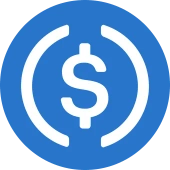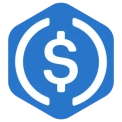USDC digital wallets serve as a secure and convenient means of managing digital assets. They enable users to have full control over their USDC holdings and conduct transactions seamlessly within the cryptocurrency ecosystem.
These digital wallets utilize blockchain technology to record and validate digital wallet transactions, ensuring transparency and security.
One of the key advantages of USDC wallets is their ability to provide stability. As a stablecoin, USDC is designed to maintain a consistent value against the U.S. dollar, mitigating the volatility typically associated with other cryptocurrencies.
This stability makes USDC an attractive choice for individuals and businesses looking for a reliable digital asset for day-to-day transactions and value storage. According to crypto market data, USDC cryptocurrency market cap is over $29B.
USDC wallets often come with user-friendly interfaces that simplify the management of digital assets. Users can easily monitor their USDC balance, track transaction history, and initiate transfers within the wallet interface.
Some wallets also offer additional features like integration with payment platforms, such as Apple Pay and Google Pay, making it convenient to use USDC for online purchases and transactions.
By leveraging USDC wallets, individuals and businesses can tap into the benefits of cryptocurrencies while enjoying the stability of the U.S. dollar. These wallets provide a secure and user-friendly gateway to participate in the digital economy, offering a seamless experience for managing and transacting USDC tokens.
How Does a USDC Wallet Work?
A USDC wallet operates on the principles of blockchain technology, ensuring secure and transparent transactions. When a user creates a USDC wallet, they are assigned a unique address, consisting of a string of characters.
This address acts as a destination for receiving USDC tokens. Transactions involving USDC are recorded on the blockchain, a decentralized public ledger that maintains a record of all transactions across the network.
To send USDC from a wallet, users need to enter the recipient's wallet address and the desired amount. The transaction information is then bundled into a block and broadcasted to the network.
Miners, who are participants in the blockchain network, validate the transaction by solving complex mathematical problems. Once the transaction is confirmed by the network, it becomes a permanent entry on the blockchain, which serves as a tamper-proof public ledger.
One notable feature of USDC wallets is their efficiency in facilitating transactions. Unlike traditional banking systems, which may take days to process international transfers, USDC transactions are usually completed within minutes. This makes USDC wallets an efficient means of transferring digital assets, whether it's for remittances, cross-border transactions, or day-to-day payments.
Security is a paramount concern when it comes to USDC wallets. They employ various security measures to safeguard users' funds and protect against unauthorized access. For instance, many wallets use encryption techniques to secure private keys, which are essential for signing cryptocurrency transactions and accessing the funds.
Additionally, some wallets offer two-factor authentication (2FA) or biometric authentication, such as fingerprint or face ID, to provide an extra layer of security.
It's important for USDC wallet users to keep their wallet information secure. This includes keeping their private keys confidential and utilizing reputable wallet providers to minimize the risk of fraudulent activities. Regularly updating the wallet software and practicing good online security habits, such as using strong passwords and avoiding suspicious links or downloads, can further enhance the security of USDC wallets.
Types of USDC Wallets
When it comes to USDC wallets, users have a range of options to choose from, each with its own characteristics and considerations. Understanding the different types of USDC wallets can help you make an informed decision about which one suits your needs best.
Mobile Wallets
Mobile wallet, also known as smartphone wallets, is an applicatione that can be installed on mobile devices such as smartphones or tablets. They offer users the convenience of accessing their USDC funds on the go, making transactions with just a few taps on the screen. Examples of popular mobile wallets include Apple Pay, Google Pay, and Cash App.
These wallets provide a user-friendly interface, allowing users to easily send and receive USDC, check their balance, and view transaction history. Mobile wallets often integrate additional security measures, such as fingerprint or face ID authentication, to ensure the safety of funds stored within the wallet.
Mobile wallets have gained popularity due to the widespread use of mobile devices and their compatibility with near field communication (NFC) technology. With mobile wallet, users can conveniently make in-store purchases by simply tapping their device on compatible payment terminals. These wallets also support the integration of other payment methods, such as credit cards or cryptocurrency debit card, allowing for seamless transitions between different forms of payment.
Web Wallets (Exchange Wallets)
Web wallets, also known as exchange wallets, are provided by cryptocurrency exchanges. These wallets are accessible through web browsers and allow users to store and manage their USDC tokens directly on the exchange platform. Popular cryptocurrency exchanges like Coinbase and Binance provide web wallets to their users.
Web wallets offer the advantage of easy accessibility since users can access their funds from any device with an internet connection. They eliminate the need for users to download and install dedicated software on their devices. However, it's important to note that web wallets rely on a trusted third party, the exchange, to secure and manage the users' USDC funds. It's crucial to choose reputable exchanges with a strong track record in security.
Web wallets often offer additional features, such as integration with trading platforms, enabling users to seamlessly transition between managing their USDC holdings and participating in digital currency trading activities. However, it's essential to remain vigilant and employ security measures such as two-factor authentication (2FA) and maintaining a strong, unique password for the exchange account to ensure the safety of funds.
Desktop Wallets
Desktop wallets are software applications installed on desktop or laptop computers. They provide users with full control over their USDC funds and are considered more secure than web wallets as they operate offline, reducing the risk of online threats. Popular desktop wallets include Exodus, Electrum, and Atomic Wallet.
Desktop crypto wallets offer features such as private key management and encryption of wallet files, ensuring that the user's USDC tokens remain secure. By storing the wallet locally on a device, users have direct control over their funds and are not dependent on third-party service providers. However, it's important to back up the wallet files and secure them with strong passwords to prevent unauthorized access.
Desktop wallets are suitable for users who prioritize security and want complete control over their USDC funds. They are particularly useful for those who frequently transact in USDC or engage in cryptocurrency trading activities, as they often provide advanced features like integration with multiple cryptocurrency exchanges, portfolio tracking, and the ability to store and manage various cryptocurrencies within a single application.
In the next sections, we will explore two additional types of USDC wallets: hardware wallets and paper wallets, each offering unique advantages in terms of security and offline storage.
Hardware Wallets
Hardware wallets are physical devices specifically designed for storing cryptocurrencies securely. These wallets provide an extra layer of protection by keeping the private keys offline, away from potential online threats. They are often regarded as one of the most secure options for storing USDC tokens.
One of the main advantages of hardware wallets is their isolation from internet-connected devices. By storing the private keys offline, hardware wallets minimize the risk of unauthorized access or hacking attempts.
The private keys never leave the device, which significantly reduces the chances of exposure to potential vulnerabilities.
Hardware wallets are typically small, portable devices that resemble USB drives. They feature a built-in screen and physical buttons, allowing users to verify and authorize crypto transactions directly on the device itself.
This added layer of verification ensures that even if the computer or mobile device used for accessing the electronic wallet is compromised, the transaction details remain secure.
Physical wallet offers excellent protection against malware and phishing attacks, as the transaction signing process takes place within the isolated device.
Even if the computer or mobile device used for accessing the wallet is compromised, the malicious software cannot manipulate the transaction details or steal the private keys.
Moreover, hardware wallets often provide backup and recovery options, allowing users to create a recovery seed or passphrase. In the event of loss, damage, or theft of the hardware wallet, users can restore their USDC funds on a new device by using the recovery seed.
This feature adds an additional layer of security and ensures that users can regain access to their funds even if the hardware wallet is lost or inaccessible.
Paper Wallets
Paper wallets provide an offline method for storing USDC tokens and are considered one of the most secure options available. They involve generating a physical copy or printout of your wallet's public and private keys, which can be stored in a safe and secure location.
To create a paper wallet, you typically use a trusted generator tool or software specifically designed for this purpose.
The generator creates a random pair of public and private keys, which are then printed out or written down on a physical medium, such as paper. It's crucial to generate the keys in an offline and secure environment to ensure their integrity.
One of the main advantages of paper wallets is their high level of security. Since the keys are stored offline, they are not susceptible to hacking or online vulnerabilities. Paper wallets are considered "cold storage," meaning they are disconnected from the internet, reducing the risk of unauthorized access.
Using a paper wallet involves a few key considerations. First, it's essential to ensure the computer or device used to generate the keys is free from malware or keylogging software that could compromise the security of the generated keys. Utilizing a trusted and reputable generator tool adds an extra layer of assurance.


